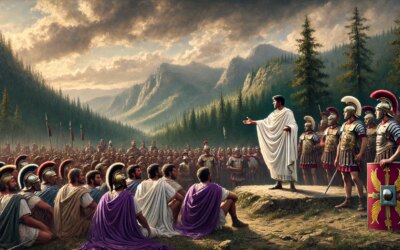Introduction: Rome’s Peak Under Trajan
In 106 AD, the Roman Empire achieved one of its greatest military victories when Emperor Trajan defeated the Dacians and annexed their kingdom. The moment was not just a military success—it was a political and economic triumph that brought enormous wealth, prestige, and stability to the empire. The scene of Trajan receiving tribute from the vanquished Dacian kings symbolized the might of imperial Rome at its zenith.
Background: Rome and Dacia Before the War
The Dacians, a fierce and resourceful people inhabiting the mountainous region north of the Danube (modern-day Romania), had long resisted Roman encroachment. Under their charismatic leader Decebalus, they had inflicted significant defeats on Roman forces in the late 1st century AD. Despite a temporary peace, Decebalus continued to challenge Roman authority, prompting Trajan to mount a full-scale invasion.
The Dacian Wars: 101–102 and 105–106 AD
Trajan launched two major campaigns against Dacia. The first culminated in a tenuous settlement, but Decebalus’ renewed defiance led to a second, more decisive war. The Romans constructed massive infrastructure, including bridges and roads, to support the campaign. After a grueling conflict, the Dacian capital of Sarmizegetusa fell, and Decebalus took his own life to avoid capture. The entire kingdom was absorbed into the Roman Empire as the province of Dacia.
Receiving the Tribute: A Grand Imperial Spectacle
In the aftermath of victory, Dacian leaders and nobles were paraded before Trajan and forced to offer tribute: gold, weapons, and hostages. This event, both symbolic and political, was a public acknowledgment of Rome’s dominance. The vast treasure acquired from Dacia—particularly gold from the Carpathian mines—helped fund major building projects in Rome and secure Trajan’s popularity.
The Triumph and Its Commemoration
Trajan was awarded a full triumph, parading through Rome in celebration. To immortalize the conquest, he commissioned the famous Trajan’s Column—a monumental spiral frieze that vividly depicts scenes from the Dacian Wars. The column stands to this day in the Forum of Trajan, not only as a work of art but also as imperial propaganda celebrating Roman power and order.
Economic and Strategic Importance
The annexation of Dacia brought substantial economic benefits. Its gold mines significantly bolstered the imperial treasury. Strategically, the new province extended Rome’s frontier to more defensible natural borders and reduced the threat of raids from beyond the Danube. Romanization of the region was swift, with colonies, roads, and fortresses transforming the landscape.
Legacy of the Dacian Campaign
Trajan’s conquest marked the high-water mark of Roman territorial expansion. Never again would the empire add such a large, resource-rich territory. His success enhanced his reputation as one of Rome’s greatest emperors and served as a model of military leadership and strategic planning. However, maintaining Dacia would prove costly in the long run, contributing to future pressures on the empire’s overstretched frontiers.
Conclusion: Rome’s Golden Hour
The scene of Trajan receiving tribute from the Dacians encapsulates a moment when Roman imperial ambition, military strength, and economic prosperity aligned. It was a crowning achievement of an era marked by expansion, order, and architectural splendor. In the shadows of the monuments it funded, the echoes of Dacia’s fall and Trajan’s triumph continue to remind us of the enduring legacy of Rome at its mightiest.






